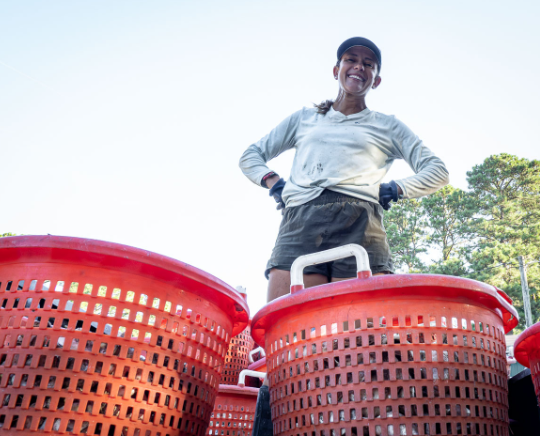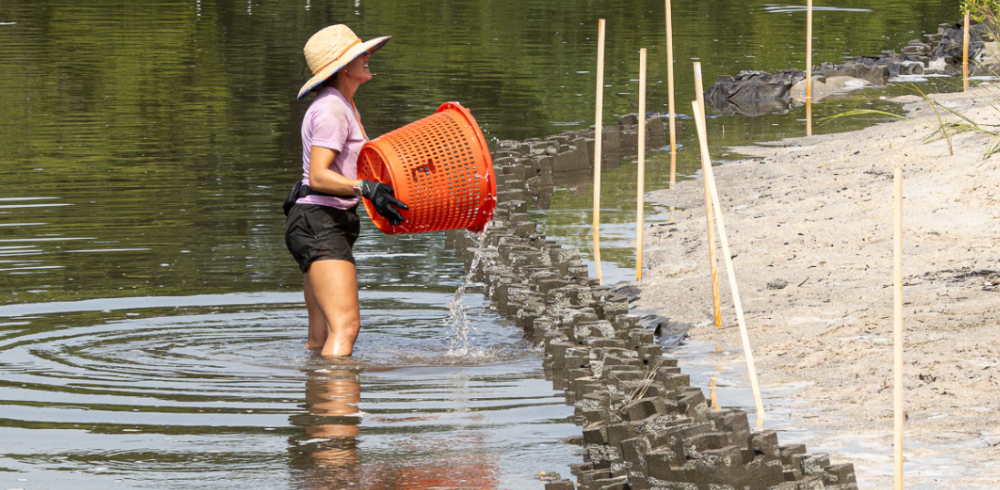This month’s Living Shoreline Collaborative Partner Highlight is Kati Grigsby. Kati is the Hampton Roads Restoration Coordinator for the Chesapeake Bay Foundation (CBF), and a close partner of the collaborative. Learn more about Kati below!
photo credits: Sue Mangan Photography

Kati hails from Onancock, VA, located on the Eastern Shore of Virginia. She holds multiple degrees, including a Master’s degree in Architectural Studies and Sustainable Design from the University of Florida, a Graduate Certificate in Geographic Information Systems from the same university, and a Master’s degree in Marine Science from the Virginia Institute of Marine Science. These qualifications have proven to be extremely useful in her current role at CBF.
Q: What experiences were foundational to you wanting to work in this field?
A: I had a strong desire to create meaningful projects that could make a positive impact on the community and the environment. After finishing my studies at UF in 2018, I got an internship at CBF. During my internship, I learned that oysters played a vital role in shaping the marine environment. This realization helped me focus my career path and ultimately led me to where I am today!
Q: What does the Chesapeake Bay Foundation do?
A: Founded in 1966, the Chesapeake Bay Foundation (CBF) is the largest independent conservation organization dedicated solely to saving the Bay. Serving as a watchdog, we fight for effective, science-based solutions to the pollution degrading the Chesapeake Bay and its rivers and streams. Our motto, “Save the Bay,” is a regional rallying cry for pollution reduction throughout the Chesapeake’s six-state, 64,000-square-mile watershed, home to more than 18 million people and 3,000 species of plants and animals. With offices in Maryland, Virginia, Pennsylvania, and the District of Columbia and 15 field centers, CBF leads the way in restoring the Bay and its rivers and streams. For more than 50 years, we have created a broad understanding of the Bay’s poor health, engaged public leaders in making commitments to restore the Chesapeake, and fought successfully to create a new approach to cleanup that features real accountability—the Chesapeake Clean Water Blueprint. But the Bay is still a system dangerously out of balance. We continue to engage in education, advocacy, litigation, and restoration to turn the tide and leave a legacy of clean water for future generations.
Q: What is your role at the Chesapeake Bay Foundation?
A: I am CBF’s Restoration Coordinator, and I manage our Hampton Roads Urban Restoration Program where we design, permit, implement, monitor, and maintain projects such as living shorelines, rain gardens/bioswales, and tree plantings.
Here is an ArcGIS StoryMap that goes into our program and the projects we have implemented: https://arcg.is/1mPjyy0
Q: How has your affiliation with the LSC affected your role and/or the impact of your organization on the geographic area you serve?
A: In 2021, CBF established an affiliation with the LSC. This step played a vital role in improving my comprehension of living shorelines and gave CBF the confidence to begin our program and eventually install our own projects in collaboration with several other LSC members.
Q: What do you hope to accomplish with the LSC in the future?
A: I would like to see how the LSC can start thinking about vegetated buffers and how those can be a standard part of living shoreline designs.

